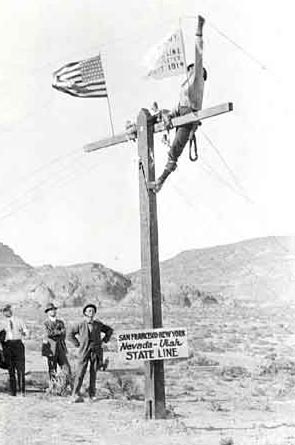Transcontinental Telephone Service
Transcontinental Telephone Service
<pageby comments="false" nominor="false"></pageby>;
The United States is a very large country and for most of its history people in one section of the nation often did not hear news of events in another section until weeks or even months later. The Post Office provided service to virtually every hamlet in the country, but letters could only travel as fast as the means of transportation would allow. The invention of the telegraph in the 1840s speeded the transmission of communication, by separating it from transportation. The telegraph remained expensive and inconvenient, so it was used primarily as a business tool. It also lacked the “expressive meaning” made possible by the telephone. Once the telephone was developed by Alexander Graham Bell in the 1870s, its potential for transcontinental communication was immediately apparent. However, the technology to build such a system was not yet available.
Two primary problems were associated with long-distance telephony. One was interference, or cross talk, from adjacent lines on the same crossarm of the telephone pole. John J. Carty discovered in 1881 that by using a “metallic” or two wire circuit (instead of a ground return), and then transposing the wires by twisting them at specified intervals canceled the cross talk. Metallic circuits allowed construction of extensive long distance connections. AT&T lines connected New York and Chicago in 1892. Another major problem was caused by distance. Over the lengths of long-distance lines, the telephone signal weakened until it fell completely silent. In a series of papers published in 1892, Oliver Heaviside, an English physicist, developed the theory behind the transmission of signals over two-wire circuits. After reading Heaviside’s papers, Michael I. Pupin of Columbia University and George A. Campbell of AT&T realized that introducing inductive coils (loading coils) at regular intervals along the length of the telephone line could significantly reduce the loss of signals within the voice band. The first long-distance application of loading coils occurred in 1900 over a 40 kilometer (25 mile) circuit in Boston. With loading coils, AT&T opened a line connecting New York and Denver in 1909.
Even with the use of loading coils, telephone communication across countries as large as the United States was not possible without some form of amplification. A mechanical amplifier, which made use of an electromagnetic receiver and a carbon transmitter, was installed in a commercial circuit between New York City and Chicago in 1904, but it was not until the emergence of electronic amplifiers that transcontinental telephone communication became truly possible. The amplifier was the first high vacuum tube triode, adapted by Harold Arnold of AT&T from Lee de Forest’s audion.
Wendover, Utah, June 17, The last pole is erected on the first transcontinental telephone line.
With Arnold’s amplifier, AT&T began construction of the line, working west from Denver, and east from Sacramento.
The first test of the transcontinental telephone line took place in July 1914, when the president of AT&T, Theodore Vail, spoke from one coast to the other—his voice boosted in Pittsburgh, Pennsylvania; Omaha, Nebraska; and Salt Lake City, Utah along the way. But the big celebration occurred on 25 January 1915 with the ceremonial opening of service to the public. The first call connected Alexander Graham Bell in New York, his old assistant Thomas Watson in San Francisco, US President Woodrow Wilson in Washington, and AT&T President Vail in Jekyll Island, Georgia. Sitting in New York, Alexander Graham Bell spoke the same words into the phone that he had first transmitted via telephony in 1877: “Mr. Watson, come here. I want you.” But this time Watson, sitting in San Francisco, replied, “It will take a week now!”
<rating comment="false"> Well Written? 1 (No) 2 3 4 5 (Yes) </rating> <rating comment="false"> Informative? 1 (No) 2 3 4 5 (Yes) </rating> <rating comment="false"> Accurate? 1 (No) 2 3 4 5 (Yes) </rating>
